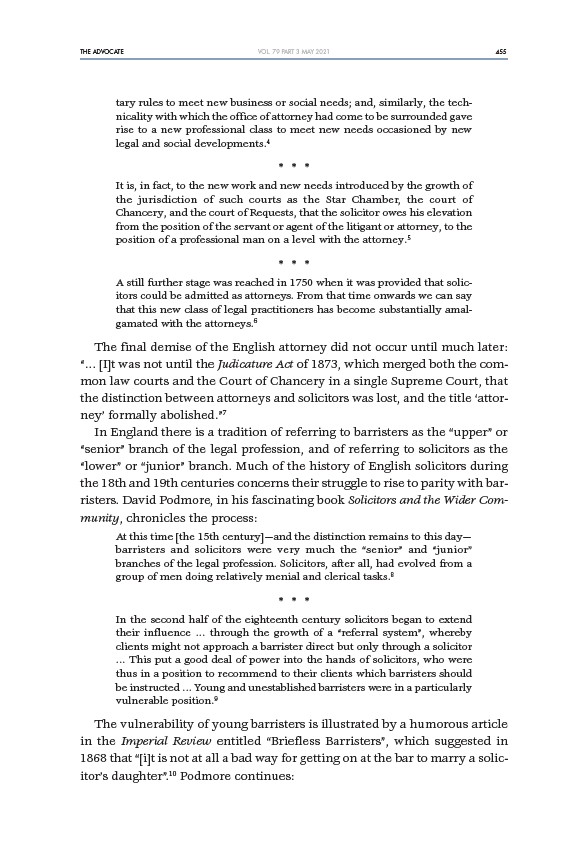
THE ADVOCATE 455
VOL. 79 PART 3 MAY 2021
tary rules to meet new business or social needs; and, similarly, the technicality
with which the office of attorney had come to be surrounded gave
rise to a new professional class to meet new needs occasioned by new
legal and social developments.4
* * *
It is, in fact, to the new work and new needs introduced by the growth of
the jurisdiction of such courts as the Star Chamber, the court of
Chancery, and the court of Requests, that the solicitor owes his elevation
from the position of the servant or agent of the litigant or attorney, to the
position of a professional man on a level with the attorney.5
* * *
A still further stage was reached in 1750 when it was provided that solicitors
could be admitted as attorneys. From that time onwards we can say
that this new class of legal practitioners has become substantially amalgamated
with the attorneys.6
The final demise of the English attorney did not occur until much later:
“… It was not until the Judicature Act of 1873, which merged both the common
law courts and the Court of Chancery in a single Supreme Court, that
the distinction between attorneys and solicitors was lost, and the title ‘attorney’
formally abolished.”7
In England there is a tradition of referring to barristers as the “upper” or
“senior” branch of the legal profession, and of referring to solicitors as the
“lower” or “junior” branch. Much of the history of English solicitors during
the 18th and 19th centuries concerns their struggle to rise to parity with barristers.
David Podmore, in his fascinating book Solicitors and the Wider Community,
chronicles the process:
At this time the 15th century—and the distinction remains to this day—
barristers and solicitors were very much the “senior” and “junior”
branches of the legal profession. Solicitors, after all, had evolved from a
group of men doing relatively menial and clerical tasks.8
* * *
In the second half of the eighteenth century solicitors began to extend
their influence … through the growth of a “referral system”, whereby
clients might not approach a barrister direct but only through a solicitor
… This put a good deal of power into the hands of solicitors, who were
thus in a position to recommend to their clients which barristers should
be instructed … Young and unestablished barristers were in a particularly
vulnerable position.9
The vulnerability of young barristers is illustrated by a humorous article
in the Imperial Review entitled “Briefless Barristers”, which suggested in
1868 that “it is not at all a bad way for getting on at the bar to marry a solicitor’s
daughter”.10 Podmore continues: